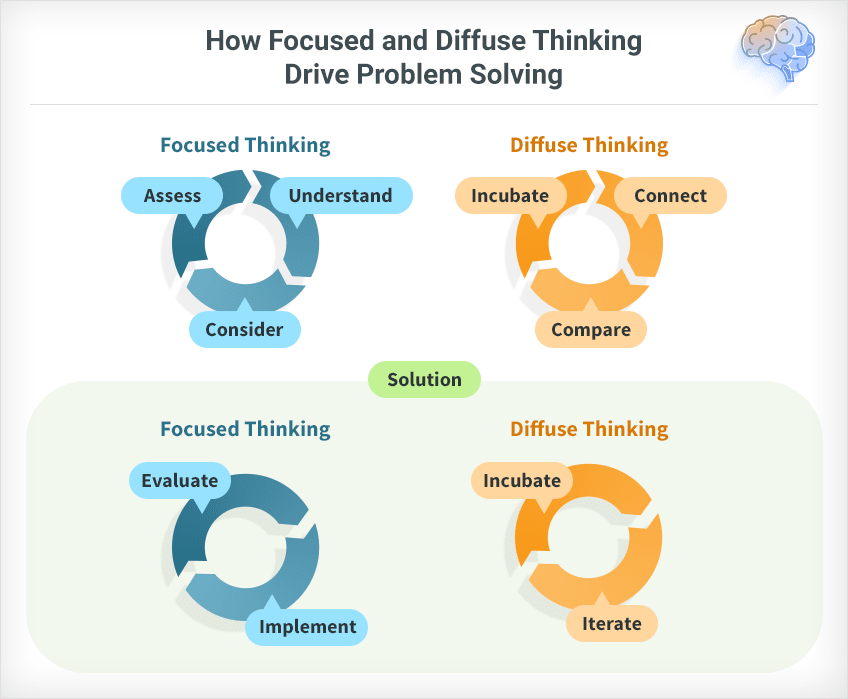It’s a great feeling when you’re on a roll at work.
You feel inspired and ready to tackle whatever’s on your to-do list for the day. You can ignore distractions and stay in the zone. It feels like quality work is just flowing straight from your brain to your fingertips.
You know that feeling when you know you’re doing a good job, yet it feels almost effortless?
It’s the best, right?
We often call this concept “flow”.
But seasoned developers already know it’s impossible (or at least really, really hard) to stay in that kind of uber-productive state forever. And it can be even harder to tap into it on demand.
No one ever said, “you know what, I don’t feel like being able to focus and think clearly today–I’d rather plod along and get distracted by cat memes.”
The limiting factor of our focus is biological. It’s how we’re wired.

The good news is this: In order to do your best work, you actually need to snap out of that kind of deeply focused thinking. You can’t maintain pure productivity over long stretches, even if you master the hell out of your workflow, process, and environment. It’s just not physically possible.
Our brains aren’t designed to maintain laser focus indefinitely. They naturally switch between two kinds of thinking — focused and diffuse. And you can learn to harness the power of both types of thinking, then put them both to work (at the right times and in the right balance) to become a more focused and productive engineer.
As good as it feels to be on that roll with clear, focused thinking, it’s actually the downtime–the diffuse thinking–that allows you to fully master a craft and do your best work. Learning how to use both focused and diffuse thinking can help software developers (and anyone else, really) do better, faster work.
Focused vs. Diffuse Thinking: What’s the Difference?
How do you tell the difference between focused and diffuse thinking?
Focused thinking is what it sounds like: conscious, focused thought. When you’re focused, you’re deliberately practicing or thinking about something — sitting down and giving it all your attention. Focused thinking utilizes your brain’s prefrontal cortex, the part right behind your forehead that controls attention and memory and helps with decision-making and problem-solving.
Examples of focused thinking:
- Writing a paper
- Doing a math problem
- Practicing a specific play on the basketball court
- Diffuse thinking happens in the background.
Rather than deliberately and consciously focusing on one thing, you’re thinking about the big picture. It’s like when you’re actively using one app on your phone, but another app is running in the background. The background app is still doing work, but it’s not at the forefront at that moment.
Diffuse thinking isn’t centered in any one part of your brain; instead, the work is spread over multiple areas.
Examples of diffuse thinking:
- Thinking about the topic of your paper in the shower
- Mulling over a math problem while taking a walk
- Playing a whole game of basketball instead of repeatedly practicing that one play
To better understand the difference between focused and diffuse thinking, think of them as a flashlight.
With focused thinking, the beam of light is small and precise. It shines an intense, bright light on a small area. That’s you, focusing all your thoughts on one task or problem.
With diffuse thinking, the beam is wider and more spread out. The light isn’t as bright in one particular direction and you may not be able to pick up on as much detail, but it allows you to see a larger area. You can see the problem or task you were working on, but you can also see the context — the big picture surrounding that focused point.
And, just like with a flashlight projecting a wide light, this added context can often allow you to think about problems in a new way or understand them from a different perspective — this is called insight.
You Need Both Focused and Diffuse Thinking
In order to truly maximize our potential and productivity, we need both focused and diffuse thinking — that’s why our brains do both.
During focused thinking, you’re learning. You’re laying the foundation for neural pathways in your brain that you’ll be able to access and follow later.
Then, when you enter a diffuse mode of thinking, those pathways already exist, so your brain is able to follow them in the background while you focus on something else. Studies have shown that diffuse thinking can help with creativity and problem solving, because it allows you to access the pathways you’ve created through focused thinking and look for patterns and connections between those new pathways and existing ones.

Think about it this way: When you were first learning how to write, you had to carefully and deliberately focus on how to draw the letters first. You literally had to think about each step of forming an “a” or “d” as you wrote them. Then you moved to the next letter and worked your way methodically through each stroke. That’s focused thinking.
But later, after you learned how to write, you could pen a whole essay without once thinking about how to form an “r” or a “p”.
That’s because your brain had the neural pathways for writing already in place. Now, you can write freely without even thinking about it, because your brain can access those pathways in the background while you’re focused on something else — like the content of what you’re writing. That’s diffuse thinking.
To learn a new skill or accomplish a task, you need both modes of thinking.
Focused thinking is what allows you to form initial skills.
Diffuse thinking allows your brain to make bigger-picture connections involving your new skills so they become second nature.
During diffuse thinking, your brain is finding lots of different ways to connect the new pathways you’ve discovered. Then, you can switch back to focused thinking to determine which of the many possible pathways are correct or most useful. This is why doing your best, most productive work requires using both types of thinking, switching back and forth between them at regular intervals.
How Developers Can Use The Focused And Diffuse Modes Of The Brain
Why is this so useful for developers? Because coding is only one part of a developer’s job.
A good developer thinks about much more than the code they’re writing, just like a good writer isn’t focused on the individual letters and strokes that make up each character.
Beyond just the literal code that’s being written, smart engineers are thinking about the big picture and how the work that they are doing is connected to work that they’ve already done, work done by the rest of the team, and the broader context of the outcome for the end user or customer.
Have you addressed all boundary cases in the unit tests?
How will a design decision affect the overall project?
How well does your code design fit into the bigger code base?
These are big-picture questions that developers need to answer if they’re going to do their best work. Yet, when coding, it can be easy to get caught up on specific bugs or problems — to miss the forest for all the trees.
For developers, it can be a good strategy to set a specific amount of time — say, 40 minutes — to spend in focused thinking mode. Code feverishly until time is up, and then do something to trigger a switch to diffuse thinking, so you can digest the work you just did, process it, and understand how it fits into a bigger picture view of the entire project.
Of course, being able to work that way requires being able to consciously switch your thinking between focused and diffuse. With practice, it’s possible. These strategies will help.
Sleep on the Problem
One of the best ways to activate diffuse thinking is by taking a quick snooze.
Thomas Edison swore by this — he could often be found taking a break from his experiments to sit and relax with ball bearings in his hands, so that when he fell asleep, the sound of the ball bearings dropping to the ground would wake him up. This ensured he was able to enter into a diffuse mode of thinking, then snap right back into focused thought when he heard the ball bearings drop.
If you’re stuck on a problem, setting an alarm and taking a short nap could lead to the “Aha” moment you need.
Take Productive Breaks
While sleeping is the “ultimate activator” for diffuse thinking, most employers don’t take kindly to developers napping at their desks.
If you find yourself stuck on a problem in the middle of the workday, when taking a nap isn’t practical, there are other ways to enter diffuse thinking.
Exercise — even if it’s just a quick walk around the building or the block — can help. So can listening to music, especially if it doesn’t have lyrics. Playing a quick game on your phone can also help you enter diffuse thinking. Even surfing the web can do the trick (as long as you don’t fall into the social media rabbit hole and derail your entire day.)
Remember, you need a break, not a full-blown distraction.
Basically, anything you can do to take a short break — five to 20 minutes is ideal — that interrupts your focus will help you enter diffuse thinking. Afterward, you should be ready to focus again.
From a work standpoint, this time is still spent on the project or problem that you are currently working on. It’s just that you can’t always solve a problem through sheer, focused thought — downtime is part of the work, too.
Embrace the Pomodoro Method
That strategy we talked about earlier, where you set a timer to do focused work, followed by activating diffuse thinking? It’s called the Pomodoro method, and many great thinkers and problem solvers swear by it.
The idea is to spend a set amount of time working with focused thought, then spend a shorter set amount of time taking a break, as both a reward and a chance for your brain to enter diffuse thought. The standard is 25 minutes of focused work, followed by a five-minute break, but you can adjust those times to find the split that works best for you.
Repeat your focused-diffuse thought cycle until the workday is over or your project is done.
Use Time Blocking
We’ve written before about the role of time blocking as a way to achieve a state of flow.
The concept is pretty simple. Schedule your day (or your week) in a way that gives you blocks of time to spend on different types of work. That is, schedule time for focused thinking (deep work) and other time for diffuse thinking (brainstorming, napping, and other downtime).

By building your day in such a way, the goal is to bake this kind of work-switching right into your routine.
No, Really, Sleep on It
If you’ve gone through a few Pomodoro cycles and still haven’t worked through a problem, it can help to step back from it until the next day. Get a good night’s sleep and let the problem percolate in your brain. The longer span of time spent in diffuse thinking mode might be just what you need to figure out a solution.
Understanding and using both modes of thinking will make you a better, more productive developer. Being focused on your work is important. But so are breaks, because they allow you to enter diffuse thinking.
Controlling your own time and being mindful of how it’s spent is an important part of a developer’s work.
Developers value autonomy, and part of that is finding ways of working that allow you to achieve mastery while using your time as productively as possible. Whether that’s embracing the power of alternating between focused and diffuse thinking, or another method — understanding what works best for you is the key to taking your work to the next level.
7pace Timetracker is the only integrated, professional time management solution for teams using Azure DevOps.








Top comments (0)